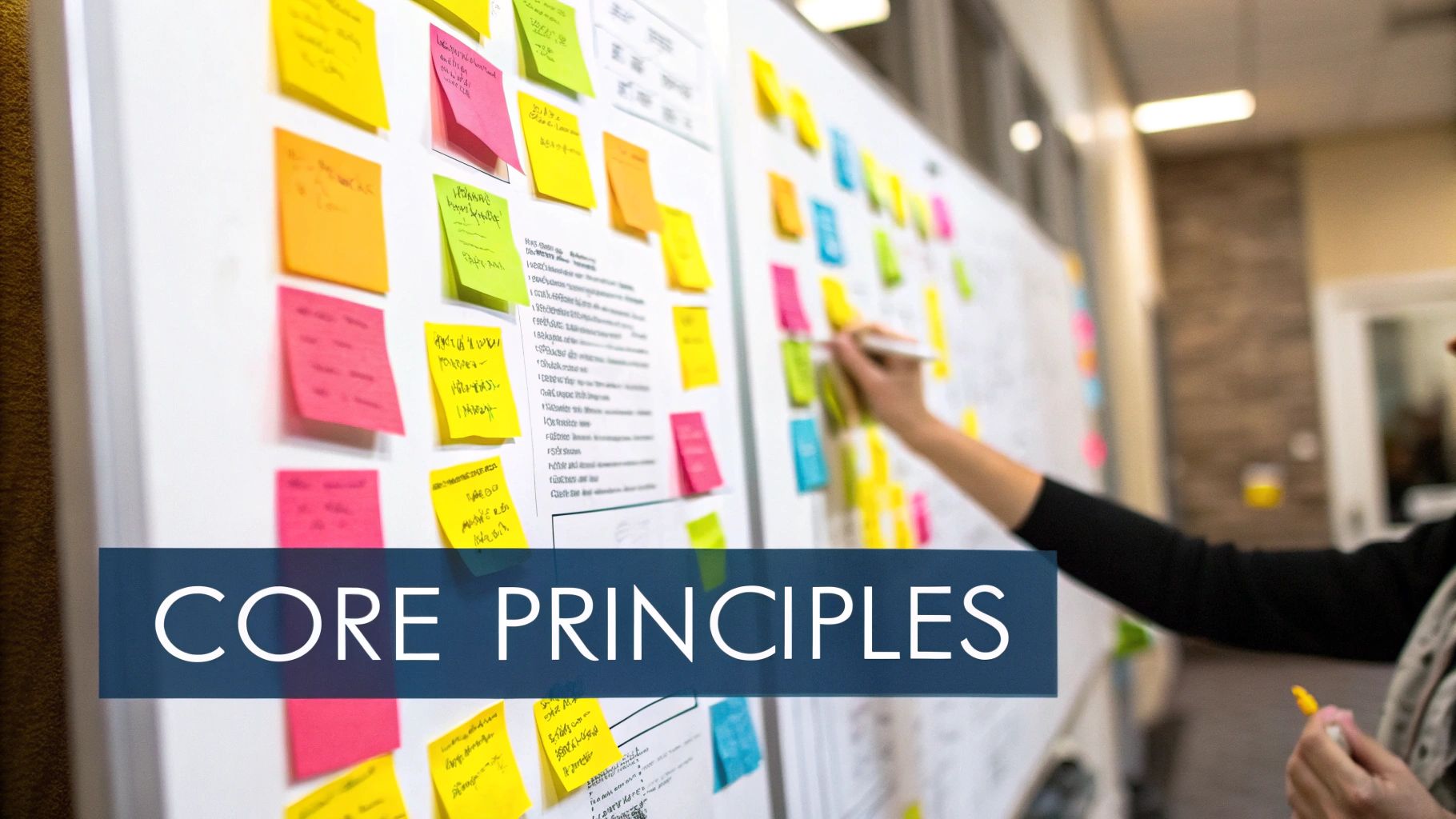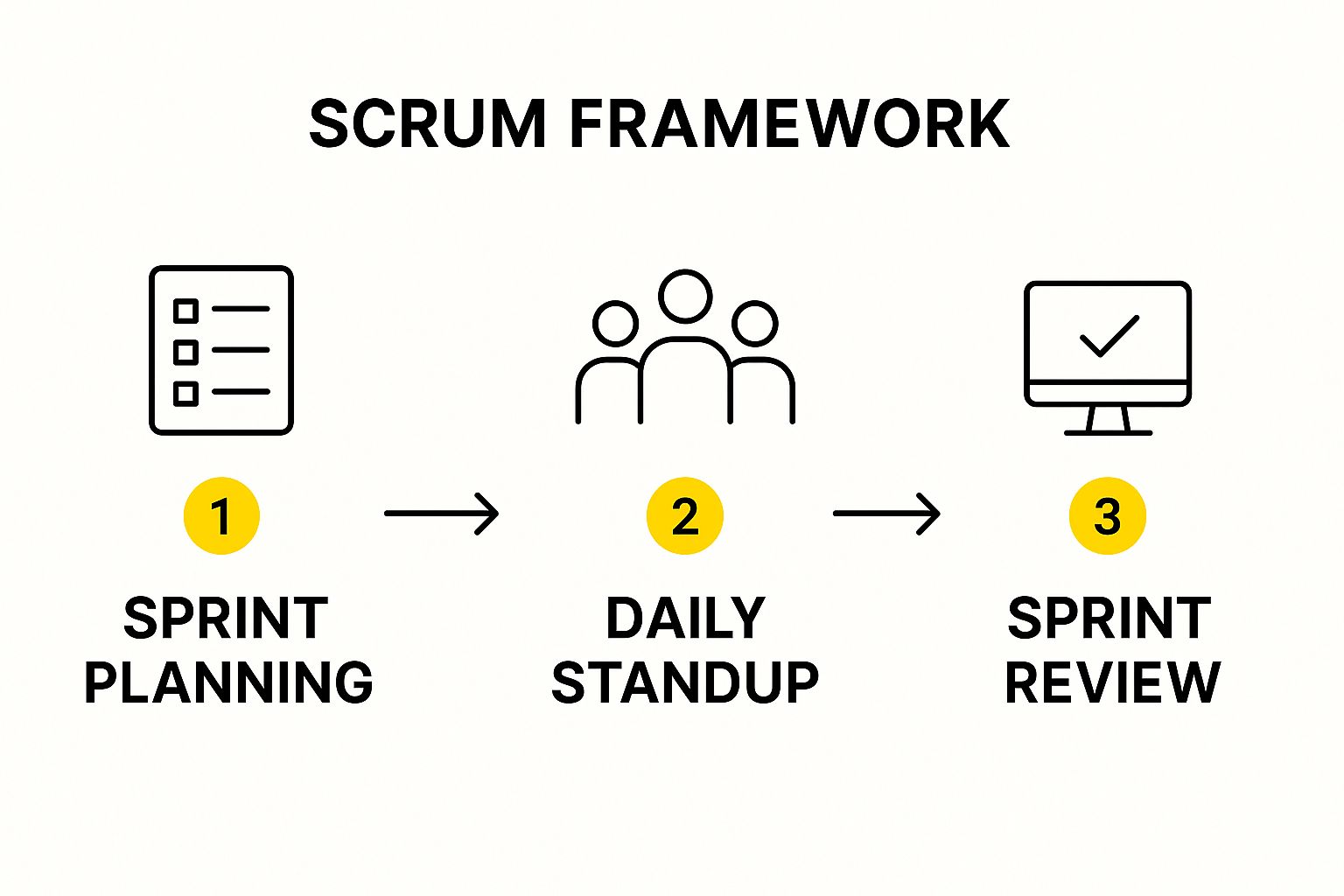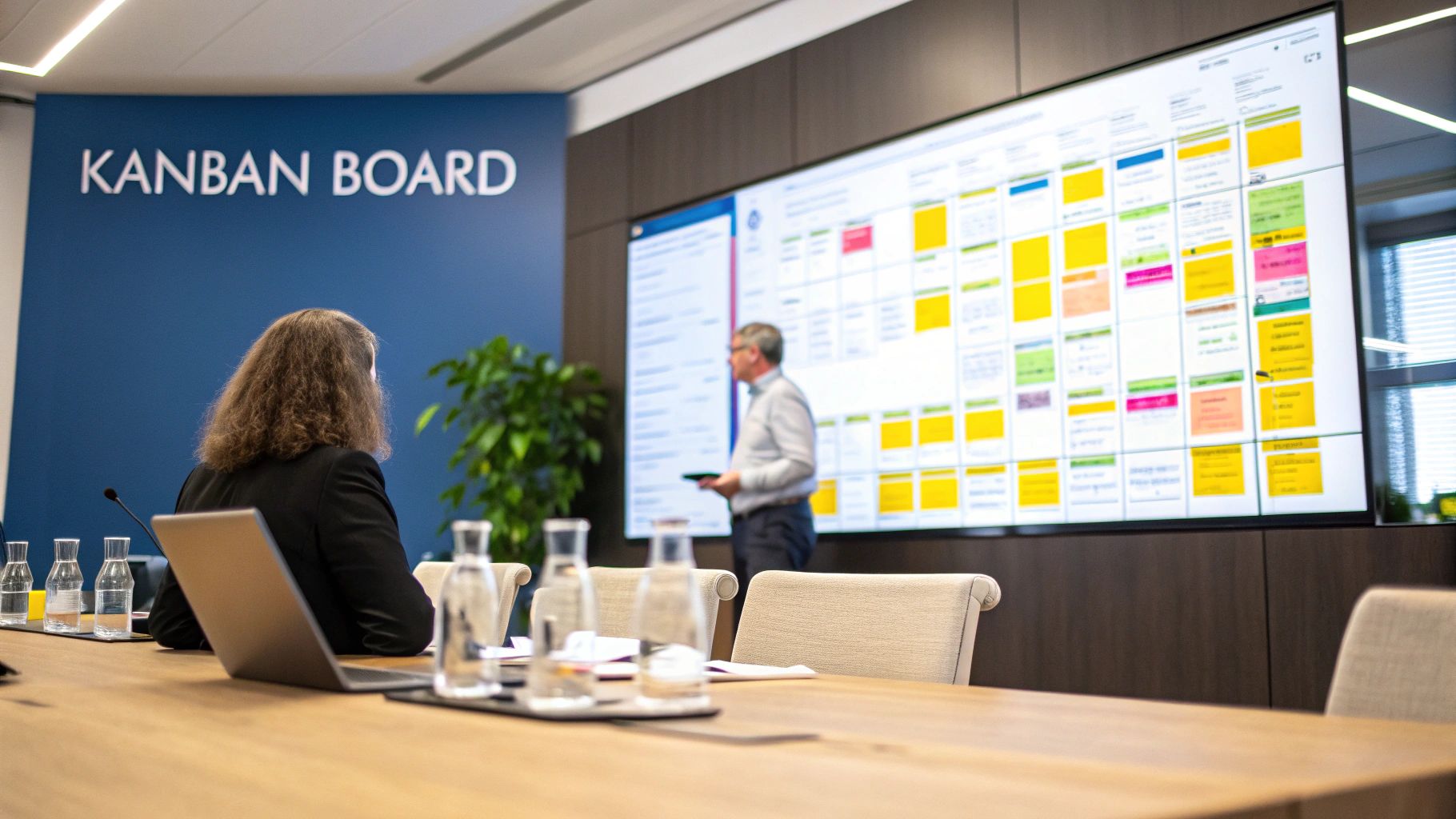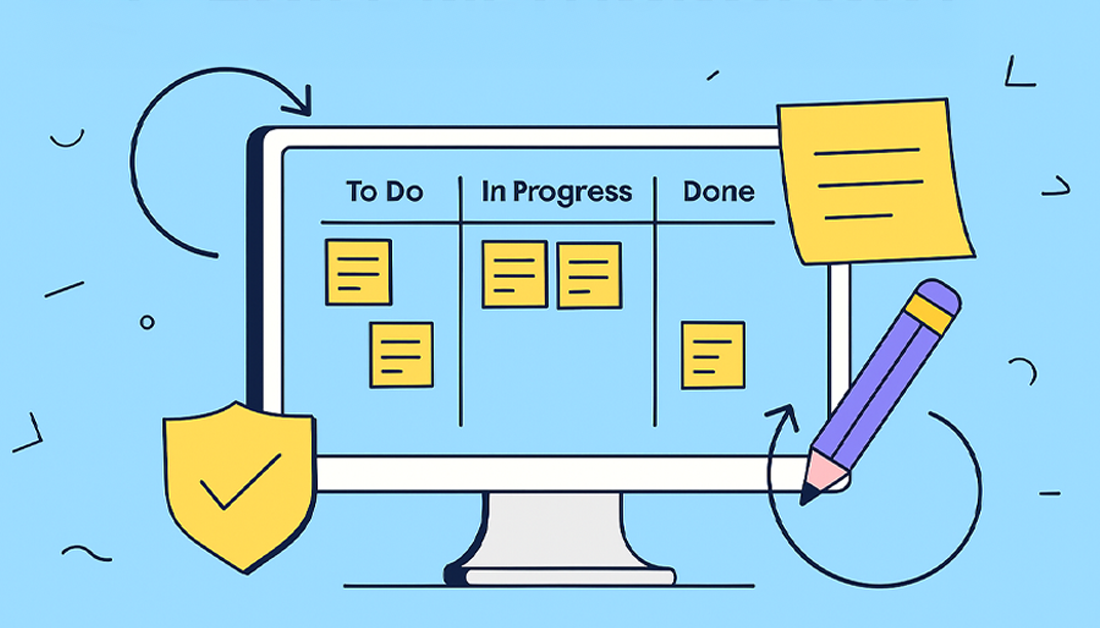The agile process methodology is all about breaking down huge, overwhelming projects into smaller, more digestible pieces called sprints. Instead of trying to plan every single detail from the start, teams work in short, focused cycles. They build a functional part of the project, get real feedback, and then adjust their plan. It’s this commitment to flexibility and continuous improvement that lets them pivot quickly and get value out the door faster.
Beyond Buzzwords: What Agile Really Means

At its heart, agile is a mindset. It’s a complete departure from the old-school, rigid ways of managing projects. Forget following a strict, unbending plan; agile is about embracing uncertainty and putting the customer’s needs first, always. While it got its start in software development, this practical approach has spread to countless other industries for one simple reason: it works.
Think of it like building a custom car. The traditional way—often called the “Waterfall” model—would mean you have to design the entire car, source every part, and assemble it from scratch before anyone gets to drive it. You only find out if you built the right thing at the very end.
An agile approach is completely different. You’d start by building a working chassis with an engine and wheels. It’s basic, but it runs. You can test drive it, get feedback, and then decide what to add next. Maybe the next sprint is dedicated to a more powerful engine, or perhaps the focus shifts to a comfortable interior. Each step delivers a small, functional improvement.
Core Philosophy: From Rigidity to Responsiveness
This iterative cycle is what truly sets agile apart. Stakeholders and customers aren’t just waiting for a big reveal months down the line. They’re part of the process, giving feedback on each small piece. This constant dialogue dramatically cuts the risk of spending time and money building something nobody actually wants.
The philosophy behind agile boils down to four simple, powerful ideas:
- Customer collaboration over rigid contract negotiation.
- Responding to change over blindly following a plan.
- Working products over exhaustive, overly-detailed documentation.
- Individuals and interactions over strict processes and tools.
This mindset is why so many organizations are making the switch. The pressure to adapt to changing market demands is immense. In fact, the global market for enterprise Agile transformation services is projected to grow at a compound annual growth rate (CAGR) of 19.5% by the end of 2026. This isn’t just a trend; it’s a reflection of the real-world value businesses are finding. You can dig into more insights about this growth in Agile services from Radixweb.
Agile Methodology vs Traditional Waterfall Model
Let’s break down the fundamental differences between the agile way of working and the more traditional Waterfall model. While Waterfall follows a straight, sequential path from start to finish, agile is cyclical, built for learning and adapting along the way. The table below highlights the key distinctions in their philosophies and how they operate.
| Characteristic | Agile Process Methodology | Traditional Waterfall Model |
|---|---|---|
| Development Cycle | Iterative and cyclical sprints | Linear and sequential phases |
| Flexibility | Highly adaptable to changes | Rigid; changes are costly and difficult |
| Customer Involvement | Continuous collaboration and feedback | Limited to initial requirements and final review |
| Delivery | Frequent, small releases of working product | Single delivery at the end of the project |
| Planning | Adaptive planning; details emerge over time | Extensive upfront planning and fixed scope |
| Risk Management | Risks are identified and mitigated in each sprint | High risk; major issues often found late |
| Focus | Delivering customer value quickly | Completing the entire project as planned |
| Documentation | Lean and functional; “just enough” | Comprehensive and exhaustive |
As you can see, the two approaches are built for entirely different environments. Agile thrives in uncertainty, making it a powerful tool for innovation and complex problem-solving.
“Agile’s power lies in its ability to manage uncertainty. In a world where customer needs and market conditions can change overnight, a methodology built on adaptation isn’t just a benefit—it’s a necessity for survival.”
This means an agile project’s scope can—and should—evolve. In contrast, a Waterfall project’s scope is locked in from the beginning. This adaptability is exactly why teams like NASA’s software engineers rely on agile. They build incredibly complex systems for missions where requirements are constantly being discovered and refined. It ensures that when it’s time for launch, the tools they’ve built are perfectly tuned for the job.
Understanding the Agile Manifesto and Principles
Agile is far more than just a project management technique—it’s a fundamental shift in how teams think about work. This entire philosophy is built on a document from 2001 called the “Manifesto for Agile Software Development.” A small group of developers created it, fed up with the rigid, slow-moving processes of the time. What they came up with were four core values that put people and results first.
These values aren’t just nice-to-haves; they are the DNA of any successful agile team. They shape every decision, every conversation, and every project outcome. Getting a feel for them is the first real step to not just “doing” agile, but truly “being” agile.
The Four Core Values of Agile
The manifesto lays out its philosophy in four simple trade-offs. It’s not saying the things on the right are worthless, but that in an agile world, the things on the left are valued far more.
1. Individuals and Interactions Over Processes and Tools
At its heart, this value is about people. While processes and tools certainly have their place, agile knows that real breakthroughs happen when skilled people talk to each other. A team that can communicate openly and hash out problems will always outperform one stuck following rigid, impersonal procedures. This is something NASA’s agile teams live by, where constant interaction is the only way to tackle completely new challenges that don’t come with a manual.
2. Working Software Over Comprehensive Documentation
In agile, the ultimate sign of progress is a product that actually works, not a mountain of paperwork. Traditional projects would get completely bogged down writing exhaustive documentation that was often obsolete the moment it was printed. Agile flips that script, focusing on building and delivering working features and creating just enough documentation to keep things moving.
This drive to deliver tangible results early and often is a cornerstone of agile. It ensures that real value is constantly getting to the customer, creating priceless opportunities for feedback based on a real product, not a theoretical plan.
3. Customer Collaboration Over Contract Negotiation
Agile treats the customer like a partner in the project, not an opponent on the other side of a negotiating table. Instead of trying to lock down every single detail in a rigid, upfront contract, agile teams bring the customer along for the ride. This continuous collaboration ensures the final product is what the customer actually needs, which often changes and evolves as the project takes shape.
4. Responding to Change Over Following a Plan
In today’s world, change is the only constant, and agile is built to embrace it. Planning is still incredibly important, but an agile plan is a living guide, not a set of stone tablets. The ability to pivot based on new information, market shifts, or user feedback isn’t seen as a project failure—it’s a massive strategic advantage.
The Twelve Guiding Principles
Backing up these four values are twelve principles that offer more specific, practical advice. Think of them as a compass for teams, helping them navigate the daily realities of complex projects. They bring key ideas to life, such as:
- Satisfying the customer by delivering valuable work frequently.
- Welcoming changing requirements, even late in development.
- Fostering daily collaboration between business stakeholders and developers.
- Building projects around motivated individuals and trusting them to deliver.
- Keeping things simple by maximizing the amount of work not done.
- Holding regular reflections to fine-tune team behaviors and processes.
Together, these principles foster an environment of continuous improvement and adaptation. They form the very soul of agile, guiding teams toward a more sustainable, responsive, and effective way to work. To see how these ideas play out in the real world, you can explore agile practices and their impact on team dynamics.
Comparing Key Agile Frameworks and Their Uses

It’s a common misconception that “Agile” is a single, one-size-fits-all method. In reality, it’s more of an umbrella term for a family of frameworks. Each one offers a different flavor of Agile principles, and choosing the right one is absolutely critical. The best fit depends on your project, team dynamics, and even your company culture.
While there are many frameworks out there, two have risen to become the undisputed leaders in the industry: Scrum and Kanban. Getting to know their core differences is the first real step toward applying the agile process methodology in a way that actually works.
Scrum: The Structured Sprint
Scrum is, without a doubt, the most popular kid on the block. Research shows a staggering 63% of agile respondents use it as their go-to framework. Think of Scrum as a series of short, well-planned races called sprints.
These sprints are time-boxed, usually lasting between one and four weeks. During this window, the team commits to delivering a specific chunk of work. This highly structured approach gives the development cycle a predictable rhythm and is defined by:
- Clear Roles: Product Owner, Scrum Master, and the Development Team.
- Prescribed Events: Sprint Planning, Daily Stand-up, Sprint Review, and Sprint Retrospective.
- Specific Artifacts: The Product Backlog and the Sprint Backlog.
It’s best suited for complex projects where requirements might shift, but you can still carve out stable, short-term goals. If you need to deliver a functional piece of the product on a regular, predictable schedule, Scrum is your friend.
For instance, a team building a new mobile banking app could use two-week sprints. The first sprint might focus on user login, the next on fund transfers. At the end of each cycle, they have a tangible, testable piece of the app. Getting that first step right is crucial; for more on that, check out these practical sprint planning tips to set your team up for success.
Kanban: The Continuous Flow
If Scrum is a series of sprints, then Kanban is a continuous relay race. The main goal here isn’t about hitting a sprint deadline; it’s about visualizing work, managing the workload, and maximizing the smooth flow of tasks from start to finish.
The Kanban board is the heart and soul of this framework. It’s a simple, visual map of your workflow. By setting Work in Progress (WIP) limits—restricting how many tasks can be in any single stage—teams can instantly spot bottlenecks and keep work moving. Unlike Scrum, Kanban is more flexible, without prescribed roles or fixed sprints.
This makes it perfect for teams dealing with a constant stream of tasks of different sizes and priorities, like an IT support desk, an operations team, or a content marketing group. It shines when rigid sprint planning feels too restrictive and the focus is on ongoing improvement.
A great example is a NASA customer support team managing technical queries. Tickets would flow across columns like “New,” “In Progress,” and “Resolved,” with WIP limits ensuring no single engineer gets swamped.
The core difference is cadence. Scrum provides a structured, time-boxed rhythm that forces regular planning and review, while Kanban offers a more fluid, event-driven flow optimized for continuous delivery.
Scrum vs. Kanban: Key Differences
So, which one is for you? It often boils down to the nature of your work and how much structure your team needs. This table breaks down the main distinctions.
| Feature | Scrum | Kanban |
|---|---|---|
| Cadence | Fixed-length sprints (e.g., 2 weeks) | Continuous flow, no fixed iterations |
| Roles | Prescribed roles (Product Owner, Scrum Master) | No required roles; teams are flexible |
| Meetings | Formal ceremonies (Sprint Planning, Daily Stand-up) | No prescribed meetings; teams meet as needed |
| Changes | Scope is locked during a sprint | Changes can be made at any time |
| Metrics | Velocity, Burndown Charts | Cycle Time, Lead Time, Throughput |
The right choice depends entirely on your context. Scrum provides a powerful pulse for product development, while Kanban excels at managing ongoing operational tasks.
Other Notable Frameworks
Scrum and Kanban get most of the spotlight, but other specialized frameworks are worth knowing. Extreme Programming (XP), for example, is laser-focused on software development. It champions technical excellence through practices like pair programming and test-driven development.
To see how these frameworks are applied in the real world, it’s worth exploring guides on specific business applications, like this one on nearshore agile software development. At the end of the day, the best agile process methodology is the one your team truly understands and can use to deliver real value, again and again.
Navigating a Typical Agile Workflow
So, how does the agile process methodology move from a theoretical concept to something your team actually does every day? The best way to get a feel for it is to walk through a typical workflow. The heartbeat of this workflow is the sprint—a short, time-boxed period where a team focuses on completing a specific set of tasks. This isn’t just a random series of meetings; it’s a predictable rhythm designed to drive progress and keep everyone in the loop.
Let’s imagine a team at NASA is building a new data visualization tool for Martian weather patterns. Instead of trying to build the whole thing at once, they break the project down into manageable, two-week sprints. Each sprint follows a clear cycle of planning, doing the work, and reflecting, which keeps the project moving forward while allowing them to adapt to new discoveries.
Kicking Off with Sprint Planning
Every single sprint starts with sprint planning. This is where the Product Owner, who is the voice of the customer and stakeholders, comes to the team with the highest-priority items from the product backlog. You can think of the product backlog as the project’s ultimate to-do list, holding every feature, fix, and requirement.
The team then works together to figure out what they can realistically pull from that list and complete in the next two weeks. Those selected items form the sprint backlog—the team’s focused to-do list for this specific sprint. It’s a negotiation, not a directive. This ensures the team fully buys into a goal they genuinely believe they can hit.
The Daily Cadence of Stand-ups
Once the sprint is underway, the team gathers for a quick, 15-minute meeting every day. This is the daily stand-up (or daily Scrum). Its purpose is simple: get in sync and keep the momentum going. Each person on the team answers three core questions:
- What did I get done yesterday?
- What am I working on today?
- Are there any roadblocks in my way?
This isn’t a status report for a manager. It’s a commitment to each other, fostering accountability and letting the team quickly rally around any problems that pop up. If a NASA developer gets stuck on a tricky algorithm, the stand-up is the perfect time to flag it and get help from a teammate right away.
This flow is what keeps a Scrum sprint moving, from planning through daily execution all the way to the final review.

As you can see, each ceremony builds on the one before it, creating a cycle that’s structured but still flexible enough to handle the unexpected.
Showcasing the Work in a Sprint Review
When the sprint ends, the team holds a sprint review. This is an informal session where the team shows off the actual, working product they built. It’s not about PowerPoints; it’s about a live demo. For our NASA team, this would mean showing stakeholders a new, functional chart or a data filter they can click on in the weather tool.
The whole point is to get immediate, honest feedback. Stakeholders can see the progress with their own eyes and offer insights that will directly influence what happens in the next sprint. This constant feedback loop is what makes agile so effective, making sure the final product is what users actually need. A good agenda is crucial for this meeting to succeed; you can find a solid sample sprint review meeting agenda to get started.
The sprint review is where value becomes visible. It’s the moment the team can proudly say, “Look at what we built,” turning abstract plans into something real that stakeholders can see, touch, and critique.
As teams move through these workflows, they’re always searching for ways to get better, especially when it comes to getting their work out the door. Exploring strategies for streamlining development operations can dramatically speed up how quickly they deliver the value they showcase in these reviews.
Reflecting and Improving with the Sprint Retrospective
The very last meeting of the sprint is the sprint retrospective. After showing off their work, the team gets together privately to talk about the sprint itself. The focus here isn’t on the product; it’s on the process.
They tackle a few key questions:
- What went really well during this sprint?
- What could we do better next time?
- What’s one thing we’ll commit to changing?
This is the engine of continuous improvement in agile. By openly discussing what worked and what didn’t, the team can make small, smart adjustments to how they work. Maybe their stand-ups ran a bit long, or perhaps their estimates were off. The retrospective is a safe place to bring these things up and agree on a plan to get better, one sprint at a time, perfecting their use of the agile process methodology as they go.
Applying Agile Beyond Software Development

While the agile process methodology was forged in the fires of software development, its core principles were simply too powerful to stay in one place. The ideas of flexibility, focusing on the customer, and making steady, iterative progress have broken out of the tech department and are now reshaping how all kinds of organizations tackle their most complex work.
This is because Agile, at its heart, is a problem-solving toolkit, not just a coding process. Any team grappling with shifting priorities, demanding deadlines, and the need for constant feedback can benefit. The proof is in the numbers, with adoption spreading rapidly across entire companies.
Recent data shows that while engineering and R&D teams are still the biggest users at 48%, other functions are closing the gap. Business operations teams now make up 28% of Agile practitioners, with marketing teams not far behind at 20%. This isn’t just a trend; it’s a fundamental shift toward more responsive and adaptive ways of working. You can see more stats on this cross-functional Agile adoption at notta.ai.
How Different Teams Make Agile Their Own
The beauty of Agile is that it doesn’t look the same everywhere. Teams aren’t just copying and pasting a process; they’re adapting its frameworks to fit their unique workflows.
Marketing Teams Running Campaigns
Imagine a marketing department using Scrum to manage a big product launch. They might break the campaign into two-week sprints:
- Sprint 1: All about audience research and nailing down the core messaging.
- Sprint 2: Time to create and A/B test ad creatives across different channels.
- Sprint 3: Focus on analyzing the initial performance data and optimizing ad spend.
This cycle lets the team react to what’s actually happening in the market. Instead of blindly sticking to an old plan, they can shift budget to the ads that are truly connecting with customers.
Human Resources Streamlining Recruitment
HR teams have found that a simple Kanban board can bring incredible transparency to the hiring pipeline. Picture a board with columns like “New Applicants,” “Phone Screen,” “Technical Interview,” “Offer Extended,” and “Hired.”
By laying out the entire process visually, the team can spot bottlenecks in a second. If too many candidates are stuck in the “Technical Interview” stage, it’s a clear signal that they need to schedule more time with the dev team. It’s a simple visual tool that makes the whole process smoother and more predictable.
Adopting Agile outside of tech is about embracing its values, not just mimicking its ceremonies. The real goal is to build a culture of rapid learning and continuous improvement, whether you’re shipping code, launching a campaign, or hiring the best talent.
The Power of a Shared Mindset
When different departments in a company all start speaking the language of Agile, something special happens. Collaboration gets a massive boost because everyone shares a common framework for setting priorities and managing expectations. A marketing team running sprints can perfectly time their content delivery with the development team’s feature release, creating a seamless experience for the customer.
Ultimately, the spread of the agile process methodology proves that its real strength lies in the mindset it creates. It gives any team a structured way to face uncertainty, put the customer first, and consistently deliver value in a world that never stops changing.
Building an Agile Culture for Lasting Success
You can run all the right ceremonies and use all the trendy tools, but if you don’t change your company’s culture, you’re just going through the motions. Adopting the agile process methodology without shifting the underlying mindset is a classic recipe for failure. Real agility isn’t about doing Agile; it’s about being Agile. And that’s a deep cultural transformation many organizations stumble over.
The journey starts by creating psychological safety. Your team has to feel secure enough to experiment, voice a different opinion, or even fail without fearing punishment. When a “failure” becomes a learning moment instead of a reason for blame, that’s when genuine innovation begins to spark.
This safety net allows trust to take root, which is the fuel for self-organizing teams. Leaders must evolve from a command-and-control mindset to one where they genuinely trust their teams to own their work and make their own decisions.
The Challenge of Cultural Transformation
Moving from a rigid, top-down hierarchy to a fluid, collaborative network is easily the toughest part of any agile transformation. It flies in the face of long-held beliefs about productivity and control. The numbers tell a compelling story about this struggle. While agile adoption in U.S. federal IT projects skyrocketed from 10% in 2011 to 80% a decade later, a different study showed North American organizations scoring a meager 32% in Agile culture maturity.
True agility is a cultural state, not a process framework. The ultimate driver of success is a collective mindset that prioritizes collaboration, transparency, and relentless improvement over simply following the rules of a methodology.
This disconnect shows that simply adopting the practices won’t get you the promised results. The real benefits come from embedding the values deep within your organization. A huge piece of this puzzle is designing the right software development team structure that actually supports these new, collaborative ways of working.
To nurture this culture, you have to measure what matters. Forget focusing only on output. The most successful agile teams track indicators of team health, happiness, and process flow. To learn more, check out our guide on the essential Agile team metrics that will help you build a culture of continuous improvement and achieve lasting success.
Frequently Asked Questions About Agile
Even with a good handle on the core ideas, some practical questions always pop up when teams first start exploring the agile process methodology. Let’s tackle some of the most common ones with clear, straightforward answers to help smooth out the transition.
Can Agile Work for Projects with Fixed Constraints?
This one comes up a lot. Can you really use Agile when you have a non-negotiable deadline and a fixed budget? Absolutely, but it requires a pretty big shift in thinking. Instead of trying to lock down the project’s scope, Agile flips the script and focuses on delivering the highest possible value within those fixed goalposts.
What this really means is that the scope becomes your only flexible variable. Teams have to get really good at working with stakeholders to ruthlessly prioritize the most critical features. The goal is to deliver a working, valuable product on time and on budget, even if it means some of the “nice-to-have” features on the original wish list have to wait for a future release.
What Is the Main Difference Between Agile and Scrum?
It’s incredibly common to mix up Agile and Scrum, but the difference is actually quite simple. Here’s a good way to think about it:
- Agile is the big-picture philosophy. It’s the set of values and principles laid out in the Agile Manifesto—things like adaptability, collaboration, and focusing on customer value. It’s the “why.”
- Scrum is a specific framework you use to put that philosophy into action. It gives you a concrete set of roles, events, and artifacts to bring the Agile mindset to life on a daily basis.
So, in a nutshell, Agile is the belief system, and Scrum is one of the most popular ways to practice it.
Does Agile Mean There Is No Planning?
This is probably one of the biggest myths out there. Agile doesn’t get rid of planning; it just changes how you do it. Gone are the days of spending months creating a massive, rigid plan for an entire year-long project. Instead, Agile champions continuous and adaptive planning.
Teams create highly detailed plans for the immediate future—usually the next sprint—while maintaining a more high-level, flexible plan for the long term, which is the product roadmap. This approach is powerful because it allows them to react to new information and shifting priorities without completely derailing the project.
Is a Project Manager Needed in Agile?
In an Agile environment, the traditional project manager role often gets a makeover, with its responsibilities absorbed by other roles on the team. While some companies might keep the title, the old-school duties of assigning tasks and micromanaging timelines are typically distributed.
The Product Owner is in charge of the “what” (the work that needs to be done), the Scrum Master facilitates the “how” (the process itself), and the Development Team takes ownership of managing their own day-to-day work. The entire focus shifts from a command-and-control style to empowering the team to self-organize and deliver great results.
Figuring out these new roles and how they interact can be tricky. For a much deeper dive, it’s worth exploring some common Agile coaching questions that are designed to help teams clarify these very responsibilities and sharpen their processes.
Ready to transform your team meetings from tedious stand-ups into dynamic, action-oriented sessions? resolution Reichert Network Solutions GmbH presents NASA – Not Another Standup App, designed to bring structure, clarity, and engagement to every Agile ceremony. Stop wasting time and start driving results.
Explore how NASA can optimize your team’s performance at https://www.resolution.de/nasa.
